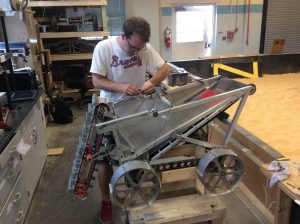
TUSCALOOSA, Ala. — Students on the Alabama Astrobotics team from The University of Alabama and Shelton State Community College will participate in the NASA Robotics Mining Competition May 18-22 at Kennedy Space Center.
As part of the competition, students are required to design a robot capable of navigating through and excavating 10 kilograms of simulated Martian regolith, a layer of loose material that covers a solid rock.
The robot is allowed two competition runs of 10 minutes each to move across the arena, through an obstacle course, and excavate as much regolith as possible. This year’s competition places additional emphasis on the robot’s ability to gather simulated ice buried beneath the regolith.
This year, the UA team is focused primarily on building a lighter, autonomous robot.
To accomplish this, the team built a new, smaller robot with a redesigned off-loading method that uses a conveyor belt to gather, store and deposit the regolith. To make the robot autonomous, the team will use Lidar sensors that use lasers to focus on a target and determine the location of the robot relative to that target.
The team will be judged on an oral presentation; a written systems engineering paper; project outreach in promoting science, technology, engineering and math disciplines; team spirit; and the mining category.
Within the mining category, the robot is judged on its overall weight, the amount of regolith collected, the amount of bandwidth required in communicating with the robot, the degree of autonomy demonstrated by the robot and the degree of dust protection demonstrated by the robot.
This is the sixth annual robotic mining competition NASA has hosted.
Made up of students from across engineering disciplines, computer science and other areas of campus, the team of UA students won the contest in 2012 and placed second last year.
The technology concepts developed by the university teams for this competition conceivably could be used to mine resources on asteroids as well as Mars, according to NASA.
The agency will directly benefit from the competition by encouraging the development of innovative excavation concepts from universities that may result in clever ideas and solutions that could be applied to an actual excavation device or payload.
Dr. Kenneth Ricks, UA associate professor of electrical and computer engineering, and Renea Randle, mathematics instructor at Shelton State Community College, serve as advisers for the team.
As part of a required educational outreach component, members of Alabama Astrobotics have hosted outreach activities on campus during E-Day and game day tailgates.
Additionally, the team has worked with students at University Place Elementary School in the Tuscaloosa City School System to introduce science and technology concepts through hands-on activities.
The team received funding from the Alabama Space Grant Consortium, NASA, Dynetics, Lockheed Martin, Nucor Steel, the UA College of Engineering, the UA Student Government Association, the UA Graduate School, and Shelton State.
Contact
Adam Jones, engineering public relations, 205/348-6444, acjones12@eng.ua.edu; Judah Martin, engineering student writer, jmmartin5@crimson.ua.edu
Source
Dr. Kenneth Ricks, 205/348-9777, kricks@eng.ua.edu